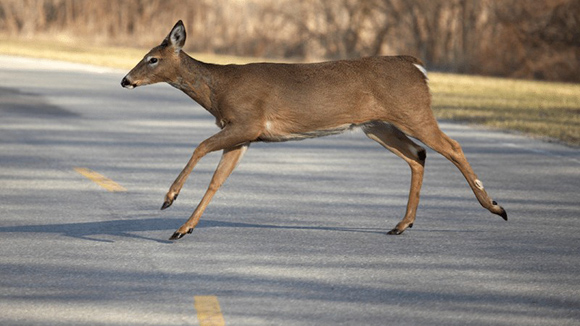ELLY GRIMM
• Leader & Times
The fall season is well under way, which means drivers on local roads could soon see an uptick in deer crossings during their travels.
With that in mind, Seward County Undersheriff Ryan Roehr said there are precautions drivers can take.
“The first thing I'd say is be watchful at dawn and dusk since deer are more active and they seldom travel alone – as the old saying goes, if you see one deer, there are probably more behind it. I would also say if you do see a deer on the road, do not swerve, because that can cause you to veer into oncoming traffic, run off the road, hit objects or overturn, and we obviously don't want anyone to get injured,” Roehr said. “You're better off either hitting the brakes slowly and as smoothly as possible and wait for it to cross or just hitting it if it's unavoidable. If you see a deer crossing sign, they’re there for a reason, so be more careful and watchful in those areas, and be especially alert and reduce speeds near wooded areas and near water sources, because that's where deer prefer to congregate. Vehicle-deer collisions can happen on any rural or urban roadway – the signs show areas where high numbers have occurred in the past. And if you're driving either in the early morning or in the evening, be sure and use bright headlights when there is no oncoming traffic – the deer’s eyes often reflect, so they'll be easier to see. In our neck of the woods, the river areas are one of the main areas where deer congregate, as well as parts of U.S. Hwy. 54 and U.S. Hwy. 83 around the bridges. We also have some areas east of town that seem to see a lot of deer, such as around Bluebell Road and Meade Lake Road. Deer season is going on right now – October is when it starts, and the peak time is about the middle of November, that’s when the peak of rut season happens and it’s when deer seem to move around a lot. Deer season typically fades down around the new year. But I would say around now through November is when people should keep their heads on a bit of a swivel and be on the lookout for deer being out and about.”
Oddly, Roehr said, the Seward County Sheriff’s officers have seen a downward trend when it comes to deer-related accidents the past couple years.
“The past couple years, it seems like we've been more on a downward trend in terms of us responding to deer-related accidents. I also said that around this time last year, and I think part of that had to do with all the construction that had been going on around U.S. Hwy. 54 and all that equipment and all those people being out there, and that had been going on a long time,” Roehr said. “There's also been some drought conditions, so that might also have something to do with that downward trend. So far, we've worked 80 accident scenes this year to date, and out of those accidents, eight of them were deer-related. Five years ago, when I started in this position, we were averaging responding to about two deer-related accidents per week around this time. I hope we keep on this downward trend we've been seeing, and I'm curious to see what the numbers will be like in the future. The construction is all done in that area, and there aren't people working there anymore, so I'm wondering what we'll be looking at in the next few years now that all of that has settled down.”
If an accident should occur, Roehr said a priority should be safety.
“The first thing people should do, if your vehicle is able to move, get it off the road onto the shoulder, turn your hazard lights on and call 911, and a deputy will arrive in minutes. Don't worry about the deer carcass, we'll take care of that side of everything,” Roehr said. “Get off the roadway and stay in your vehicle, and we'll take your report when we get to your location. Our main focus is your safety. If you DO have to get out of the vehicle, make sure you're still off the roadway. If your vehicle is disabled, turn your hazards on, make sure there's no oncoming traffic, and make your way to the shoulder while you wait for us to respond. Anyone involved in a collision with a deer or other animal resulting in personal injury or property damage totaling $1,000 or more is required to immediately report the incident to the nearest law enforcement agency.”
With deer season in swing, Roehr said the most important thing drivers can do is pay attention.
“You can only see so much when it’s dark outside, so make sure you have your seatbelt on and have your lights on, especially at those peak hours so you can have a better view of everything,” Roehr said. “And keep an eye particularly on any ditches you might pass, because that’s where deer tend to congregate, and they seem to always wait until the last second do anything. If you come across a deer, slow down gently, and hopefully they won’t make the decision to jump right in front of you. Be alert, deer can congregate anywhere and everywhere, so make sure you’re paying attention as much as possible. Like we always say, wear your seatbelt and if you do end up needing our assistance, we’ll be there to help you out. In the coming months, I hope everyone pays attention to the roads since this is the deer season because again, we don't want anyone to get hurt. Just take a few precautions and be sure and pay extra attention when you're on the roads, and you should be okay.”











